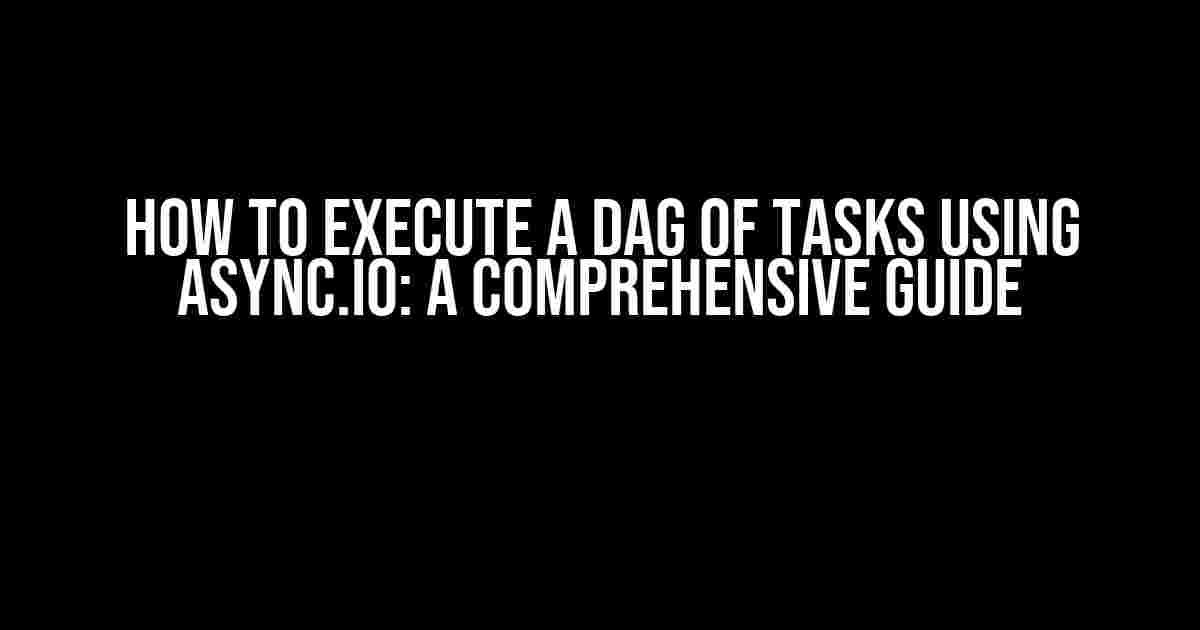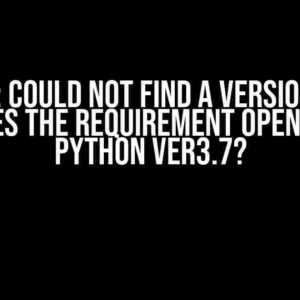Are you tired of dealing with complex task dependencies and synchronization issues in your Python applications? Look no further! Async.io is here to rescue you. In this article, we’ll explore how to execute a Directed Acyclic Graph (DAG) of tasks using Async.io, ensuring efficient and scalable task execution.
What is a DAG of Tasks?
A DAG of tasks is a collection of tasks with dependencies between them, represented as a directed graph. Each task can have multiple dependencies, and the graph is acyclic, meaning there are no circular dependencies. This structure allows for efficient task scheduling and parallel execution.
What is Async.io?
Async.io is a Python library that provides an asynchronous framework for building concurrent and scalable applications. It allows you to write asynchronous code using coroutines, multiplexing I/O access over sockets and other resources, and implementing network clients and servers.
Why Use Async.io for DAG Execution?
Async.io is an ideal choice for executing a DAG of tasks due to its:
- Faster execution times: Async.io’s asynchronous nature enables parallel task execution, reducing overall execution time.
- Simplified code: Async.io’s high-level API abstracts away low-level I/O operations, making it easier to write and maintain complex task dependencies.
- Scalability: Async.io’s design allows it to handle a large number of tasks and dependencies with ease.
Setting Up Async.io for DAG Execution
To get started with executing a DAG of tasks using Async.io, you’ll need to install the library. You can do this using pip:
pip install async-ioCreating a DAG of Tasks
To create a DAG of tasks, you’ll need to define a graph structure that represents the dependencies between tasks. You can use a dictionary to store the task dependencies, where each key represents a task and the value is a list of dependencies:
dag = {
'task1': ['task2', 'task3'],
'task2': ['task4'],
'task3': ['task4', 'task5'],
'task4': [],
'task5': []
}
Executing the DAG of Tasks using Async.io
Now that you have your DAG of tasks, it’s time to execute it using Async.io. You’ll need to create an async function for each task and use the `asyncio.gather` function to execute the tasks concurrently:
import asyncio
async def task1():
# task 1 implementation
print("Task 1 executed")
async def task2():
# task 2 implementation
print("Task 2 executed")
async def task3():
# task 3 implementation
print("Task 3 executed")
async def task4():
# task 4 implementation
print("Task 4 executed")
async def task5():
# task 5 implementation
print("Task 5 executed")
async def execute_dag(dag):
tasks = []
for task, dependencies in dag.items():
if not dependencies:
tasks.append(globals()[task]())
else:
tasks.append(execute_dag({task: dependencies}))
await asyncio.gather(*tasks)
async def main():
await execute_dag(dag)
asyncio.run(main())
This code defines five async functions for each task and an `execute_dag` function that recursively executes the tasks based on their dependencies. The `main` function calls `execute_dag` with the original DAG, and `asyncio.run` is used to run the `main` function.
Handling Task Failures and Retries
In real-world scenarios, task failures are common. To handle task failures and retries, you can use Async.io’s `try-except` blocks and `asyncio.sleep` function:
async def execute_dag(dag):
tasks = []
for task, dependencies in dag.items():
if not dependencies:
try:
await globals()[task]()
except Exception as e:
print(f"Task {task} failed: {e}")
await asyncio.sleep(1) # retry after 1 second
await execute_dag({task: dependencies})
else:
tasks.append(execute_dag({task: dependencies}))
await asyncio.gather(*tasks)
This modified `execute_dag` function catches any exceptions raised during task execution, prints an error message, and retries the task after a 1-second delay.
Visualizing the DAG Execution
To visualize the DAG execution, you can use a library like `graphviz`. Install it using pip:
pip install graphvizThen, modify the `execute_dag` function to generate a DAG visualization:
import graphviz
async def execute_dag(dag):
graph = graphviz.Digraph()
for task, dependencies in dag.items():
graph.node(task)
for dependency in dependencies:
graph.edge(dependency, task)
graph.render("dag")
# execute tasks as before
This code generates a DAG visualization using graphviz and saves it to a file named `dag`. You can open this file to visualize the task dependencies.
Best Practices for DAG Execution using Async.io
To ensure efficient and scalable DAG execution using Async.io, follow these best practices:
- Keep tasks short and concise: Break down complex tasks into smaller, independent tasks to enable parallel execution.
- Use async-friendly libraries: Ensure that the libraries used in your tasks are async-friendly to avoid blocking the event loop.
- Handle task failures gracefully: Implement robust error handling and retry mechanisms to handle task failures.
- Monitor and visualize DAG execution: Use visualization tools like graphviz to monitor and analyze DAG execution, identifying bottlenecks and optimization opportunities.
- Test and debug thoroughly: Thoroughly test and debug your DAG execution code to ensure correctness and performance.
Conclusion
In this article, we’ve covered the basics of executing a DAG of tasks using Async.io. By following the instructions and best practices outlined above, you can efficiently and scalably execute complex task dependencies in your Python applications. Remember to keep your tasks short, handle failures gracefully, and visualize your DAG execution to ensure optimal performance.
| Keyword | Description |
|---|---|
| Async.io | A Python library for building concurrent and scalable applications |
| DAG | Directed Acyclic Graph, a collection of tasks with dependencies |
| Coroutines | Functions that can yield control to other coroutines |
By mastering Async.io and DAG execution, you’ll be well-equipped to tackle complex task dependencies and build scalable, high-performance applications.
Frequently Asked Question
Are you ready to take your task execution to the next level with async.io? Here are the most frequently asked questions about executing a DAG of tasks using async.io!
What is a DAG of tasks, and why do I need async.io?
A DAG (Directed Acyclic Graph) of tasks is a collection of tasks that depend on each other, where each task can have multiple dependencies. async.io is a powerful library that allows you to execute these tasks efficiently and concurrently, making the most of your system’s resources. With async.io, you can define complex workflows, handle dependencies, and even visualize your task graph – all in a few lines of code!
How do I define a DAG of tasks using async.io?
To define a DAG of tasks, you’ll need to create a list of tasks, where each task is an instance of the `asyncio
How does async.io handle task dependencies?
async.io uses a clever algorithm to resolve task dependencies at runtime. When a task is executed, async.io checks its dependencies and waits for them to complete before proceeding. If a dependency is missing, async.io will automatically schedule it for execution, ensuring that your tasks are executed in the correct order. This way, you can focus on defining your tasks, while async.io takes care of the dependencies!
Can I visualize my task graph with async.io?
Yes, you can! async.io comes with built-in support for visualization using graphviz. Simply call the `async.io.graph.visualize()` method, and async.io will generate a beautiful graph showing your task dependencies. This is super helpful for debugging and understanding the flow of your tasks. Visualize your task graph and get ready to be amazed!
How do I handle errors and retries in async.io?
async.io provides built-in support for error handling and retries. You can specify a retry policy for each task, and async.io will automatically retry failed tasks according to your policy. You can also define custom error handlers to catch specific exceptions and take corrective action. With async.io, you’re in control of how your tasks behave in the face of errors!



